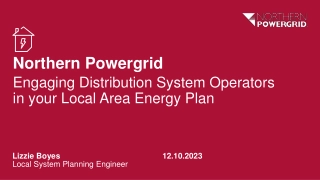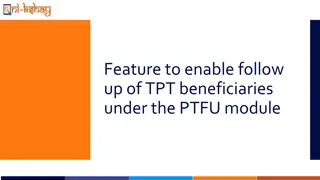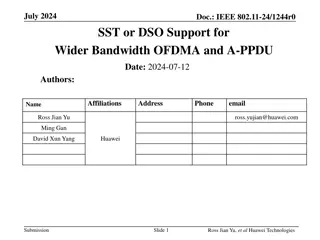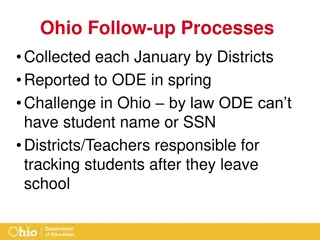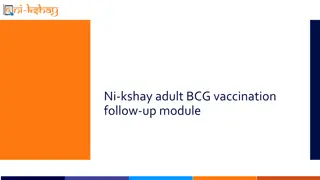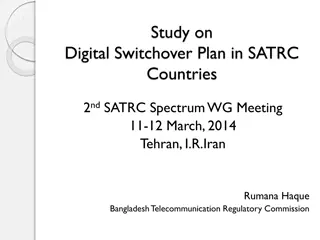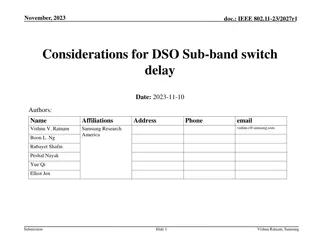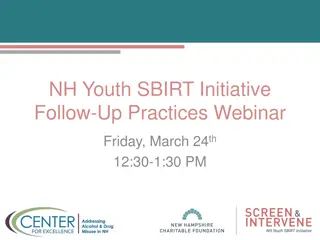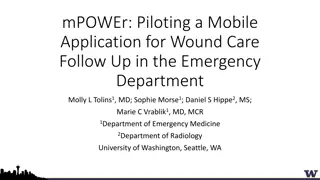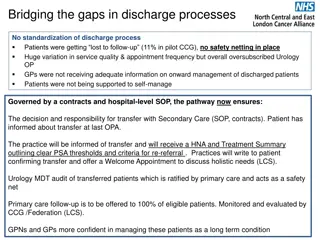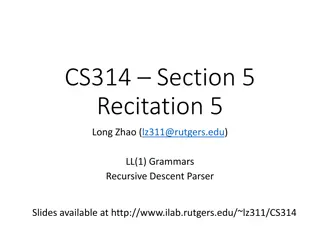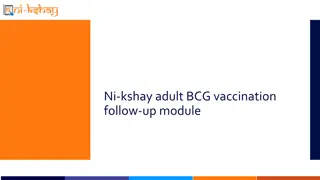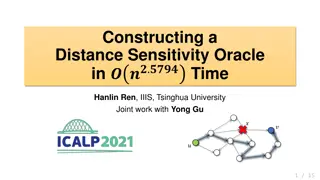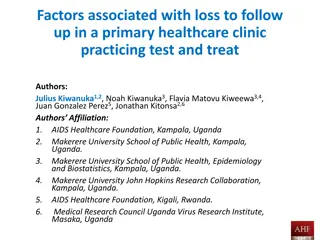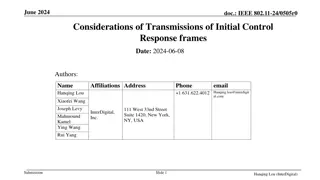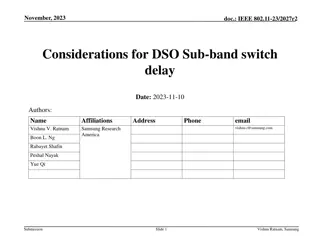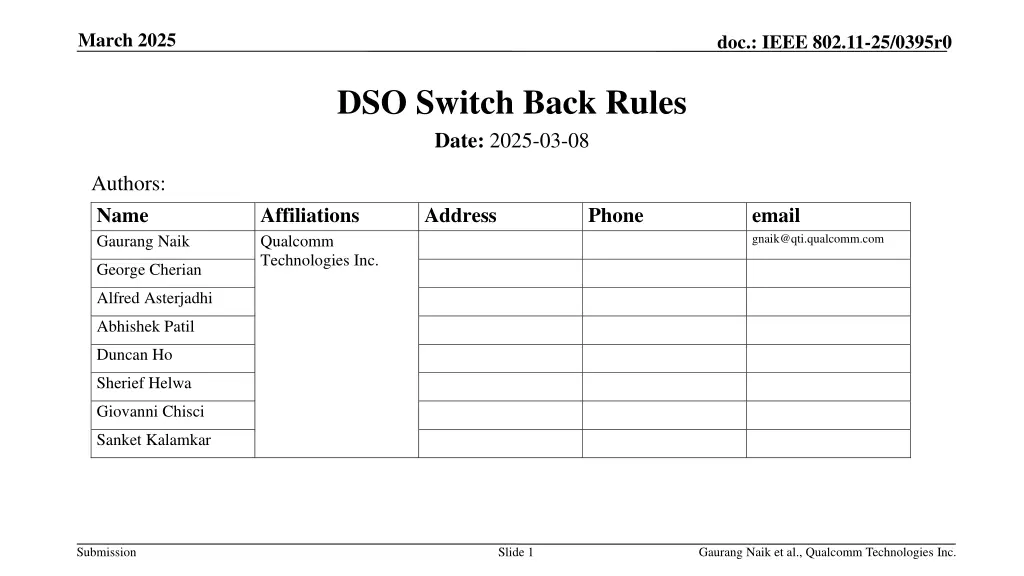
Enhanced Spectral Efficiency for IEEE 802.11 Wi-Fi Networks
Explore how IEEE 802.11 Wi-Fi networks can achieve enhanced spectral efficiency by addressing underutilized bandwidth when clients do not support full bandwidth options. The document discusses the DSO switch back rules and mechanisms to optimize resource utilization for better network performance.
Download Presentation

Please find below an Image/Link to download the presentation.
The content on the website is provided AS IS for your information and personal use only. It may not be sold, licensed, or shared on other websites without obtaining consent from the author. If you encounter any issues during the download, it is possible that the publisher has removed the file from their server.
You are allowed to download the files provided on this website for personal or commercial use, subject to the condition that they are used lawfully. All files are the property of their respective owners.
The content on the website is provided AS IS for your information and personal use only. It may not be sold, licensed, or shared on other websites without obtaining consent from the author.
E N D
Presentation Transcript
March 2025 doc.: IEEE 802.11-25/0395r0 DSO Switch Back Rules Date: 2025-03-08 Authors: Name Gaurang Naik Affiliations Qualcomm Technologies Inc. Address Phone email gnaik@qti.qualcomm.com George Cherian Alfred Asterjadhi Abhishek Patil Duncan Ho Sherief Helwa Giovanni Chisci Sanket Kalamkar Submission Slide 1 Gaurang Naik et al., Qualcomm Technologies Inc.
March 2025 doc.: IEEE 802.11-25/0395r0 Recap Many Wi-Fi clients do not support the full bandwidth option supported by the AP While APs may support up to 320 MHz, client may support only 80 MHz, or 160 MHz When the AP has traffic for multiple STAs, if at least one client is wideband, Multi-User OFDMA can be used to schedule Resource Units (RUs) to the wideband STA in S80 or S160 If no such client exists, large portions of the operational bandwidth go underutilized, leading to poor spectral efficiency 802.11bn must address such underutilization by allowing narrowband devices to use different portions of the operational bandwidth Frequency S80 WIFI 7 Unutilized resource In-BSS Transmission to 160 MHz STA S40 In-BSS Transmission to 40 MHz STA S20 P20 subchannels Time Submission Slide 2 Gaurang Naik et al., Qualcomm Technologies Inc.
March 2025 doc.: IEEE 802.11-25/0395r0 Recap DSO operation comprises three parts: Switch from primary sub-band to DSO sub-band upon receiving the DSO initial Control frame Frame exchanges between the AP and the DSO STA on the DSO sub-band Switch back from the DSO sub-band to the primary sub-band after the end of the frame exchange sequence Frequency BSR Ack In-BSS Transmission to 80 MHz STA2 BSRP Trigger frame P A D D I N G STA2 BSS bandwidth (UL) (DL) (UL) Switch back operation non-HT dup PPDU BSR In-BSS Transmission to 80 MHz STA1 Ack STA1 (DL) (DL) (UL) (UL) P20 Time STA1 parked on P20 Initial Control frame exchange to facilitate DSO switching Subsequent frame exchanges Submission Slide 3 Gaurang Naik et al., Qualcomm Technologies Inc.
March 2025 doc.: IEEE 802.11-25/0395r0 DSO Switch Back Rules The DSO mechanism bears similarities with the eMLSR operations defined in 802.11be eMLSR DSO Switching Reception of ICF switch to the link on which ICF is received Reception of ICF switch to the DSO sub-band indicated in the ICF Frame exchanges Subsequent frame exchanges are performed on the eMLSR link on which ICF was received Subsequent frame exchanges are performed on the DSO sub-band indicated in the DSO ICF Switch back At the end of the frame exchanges, switch back to listening operation on all eMLSR links At the end of the frame exchanges, switch back to the primary sub-band Owing to their similarities, we propose that the switch back rules for DSO be the same as those defined in eMLSR, which involve: After the last transmitted or received frame, wait for an observation period of aSIFSTime + aSlotTime + aRxPHYStartDelay to check for more incoming frames from the AP If no frame addressed to the STA is received by the DSO STA until the end of the observation period, initiate switch back Submission Slide 4 Gaurang Naik et al., Qualcomm Technologies Inc.
March 2025 doc.: IEEE 802.11-25/0395r0 DSO Switch Back Operation The entire DSO frame exchange sequence, including the switch back operation is illustrated below After STA2 sends the ACK, it waits on S80 for an additional timeout interval of aSIFSTime + aSlotTime + aRxPhyStartDelay Frequency When no frame is addressed to STA2 during the timeout interval, it initiates switch back to P20 BSR Ack In-BSS Transmission to 80 MHz STA2 BSRP Trigger frame P A D D I N G STA2 BSS bandwidth (UL) (DL) (UL) non-HT dup PPDU At the end of the DSO transition delay, STA2 has parked its radio back on P20 BSR In-BSS Transmission to 80 MHz STA1 Ack STA1 (DL) (DL) (UL) (UL) P20 Time DSO Switch Back Delay STA1 parked on P20 Initial Control frame exchange to facilitate DSO switching Subsequent frame exchanges Submission Slide 5 Gaurang Naik et al., Qualcomm Technologies Inc.
March 2025 doc.: IEEE 802.11-25/0395r0 Conclusions In this presentation, we focus on the DSO switch back rules After the end of the DSO frame exchanges between the AP and DSO STA, the DSO STA must switch back from the DSO sub-band to the primary sub-band We propose to have the same rules as eMLSR for a DSO STA to switch back from DSO sub-band to the primary sub-band Submission Slide 6 Gaurang Naik et al., Qualcomm Technologies Inc.
September 2024 doc.: IEEE 802.11-25/0395r0 Straw Polls Do you agree to have the same rules as eMLSR for a DSO STA to switch back from DSO sub-band to the primary sub-band? Whether there are other conditions is TBD Submission Slide 7 Gaurang Naik et al., Qualcomm Technologies Inc.

